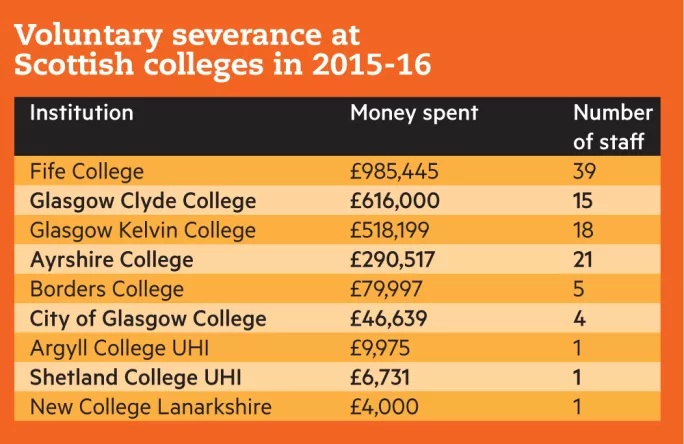Colleges shell out £2.5m on layoffs as budgets tighten

More than 150 people left the Scottish college sector last year through redundancy schemes, TESS can reveal, costing more than £2.5 million at a time when further education institutions are preparing for even tighter budgets in the coming years.
While only 10 of the 22 colleges that responded to a TESS freedom of information request said they had used voluntary redundancy in 2015-16, the majority of the remaining colleges sought to cut their wage bill via non-replacement of staff and “natural wastage”.
This comes after a report by Audit Scotland in August showed that the number of staff in the sector rose in 2014-15 for the first time since the government’s regionalisation process led to hundreds leaving - in most cases under voluntary severance schemes.
However, senior leaders have long said that the difficult financial climate colleges face, combined with increasing demands on the sector, leave staff reductions as one of the few options available to achieve efficiencies. More pressure was heaped on when Scotland’s FE minister, Shirley-Anne Somerville, said she was unable to rule out the prospect of additional budget cuts after the Westminster government’s Spending Review next week.
Strike action over pay
A lack of funding has been the key argument used by college managers reluctant to give in to union demands in the national bargaining process, which led to strike action by the support staff union Unison last month.
The TESS analysis demonstrates the different ways in which colleges are trying to ensure financial viability through reduced staff expenditure - in some cases at significant short-term cost.
In 2015-16, at nine colleges where staff left under voluntary severance, more than £2.5 million was spent on the 105 people involved. Fife College alone spent nearly £1 million on redundancies for 39 staff, followed by Glasgow Clyde and Glasgow Kelvin colleges, each of which spent more than £500,000 on 15 and 18 staff respectively.
‘This is typical of a sector that refuses to take direction from the government’
In addition, Edinburgh College had 40 staff leave through voluntary redundancy in a single year - the largest number in the sector. But it did not disclose how much it had spent.
The analysis also reveals that Fife College let six staff go through compulsory severance - a measure the sector was urged to avoid by the Scottish government in the run-up to the merger process. And West Highland College UHI had one compulsory redundancy. Of the colleges that did not use voluntary severance, six said they had employed other measures to reduce staff numbers.
Larry Flanagan, general secretary of the EIS teaching union, said it was clear that the reorganisation of the college sector had enabled many institutions to cut jobs.
“Regionalisation was intended to create a more effective further education sector and was not about cutting staff or capacity,” he said. “College finances are suitably robust to allow colleges to meet their obligations to students and staff, or they would not have agreed to the national pay agreement.”

‘Ignoring guidelines’
A spokesman for Unison said: “This strikes me as being typical of a sector which refuses to take direction from the Scottish government. From ignoring guidelines on voluntary severance packages to refusing to meet Unison to resolve the damaging industrial dispute two weeks ago, it’s not entirely surprising that colleges made people compulsorily redundant without reference to the Scottish government’s wishes.
“Pay rises to meet rising inflation need to be worked into long-term funding plans for colleges and, in our opinion, money needs to be ringfenced to pay for it.”
A spokeswoman for Fife College said: “A small number of roles and contracts continued to be reviewed as part of the ongoing management of Fife College, and where these had come to an end or were no longer required, a redundancy process was followed.”
Clyde and Kelvin colleges said the severance schemes were made necessary by Glasgow’s curriculum and estates plan, which involved a reduction in provision at both institutions.
Glasgow Kelvin College principal Alan Sherry said: “While teaching staff were able to transfer [under the TUPE process], this was not the case for management or support staff. Therefore, the college was required to further reduce its cost base, which it sought to achieve through voluntary severance with the support of the Scottish Funding Council.”
A spokeswoman for Glasgow Clyde College added that a number of voluntary staff reductions had taken place across a range of teaching and support areas, including a number of management-level posts.
You need a Tes subscription to read this article
Subscribe now to read this article and get other subscriber-only content:
- Unlimited access to all Tes magazine content
- Exclusive subscriber-only stories
- Award-winning email newsletters
Already a subscriber? Log in
You need a subscription to read this article
Subscribe now to read this article and get other subscriber-only content, including:
- Unlimited access to all Tes magazine content
- Exclusive subscriber-only stories
- Award-winning email newsletters